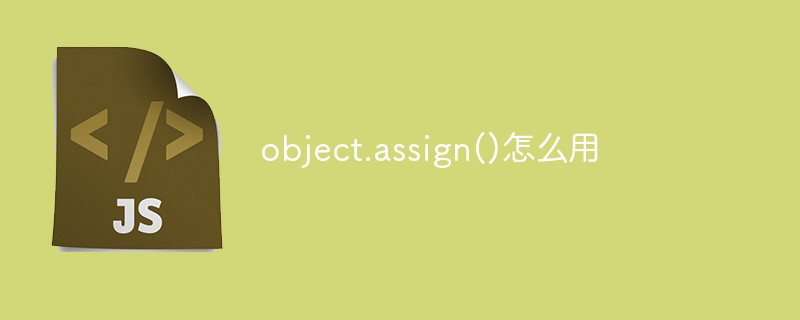Home > Article > Web Front-end > How to use object.assign()
The object.assign() method is used to assign the values of all enumerable properties from one or more source objects (sources) to the target object (target), and return the target object; syntax "Object.assign (target, ...sources)", the parameter "target" refers to the target object, which is the object that receives the properties of the source object, and is also the modified return value. The parameter "sources" refers to the source object, which contains the properties that will be merged.

The operating environment of this tutorial: windows7 system, javascript version 1.8.5, Dell G3 computer.
Usage of Object.assign()
This method is used to assign the values of all enumerable properties from one or more source objects (sources) is assigned to the target object (target) and returns the target object.
Object.assign(target, ...sources)
target: Target object, the object that receives the properties of the source object, and is also the modified return value.
sources: Source object, containing the properties to be merged.
const target = { a: 1, b: 2 };
const source1 = { b: 4, c: 5 };
const source2 = { b: 6, c: 7 };
const obj = Object.assign(target,source1,source2);
console.log(obj); // (a: 1, b: 6, c: 7)
Note:
1. Source object attributes and target object attributes If different, it will be copied to the target object;
2. If the target object and the source object have the same attributes, the attribute values of the target object will be overwritten by the attribute values of the source object;
3. If there are multiple If two source objects have the same properties, then the properties of the target object will be overwritten by the properties of the last source object.
2. Inherited properties and non-enumerable properties cannot be copied
const obj1 = Object.create({foo: 1}, { // foo 是个继承属性。
bar: {
value: 2 // bar 是个不可枚举属性。
},
baz: {
value: 3,
enumerable: true // baz 是个自身可枚举属性。
}
});
const obj= Object.assign({}, obj1);
console.log(obj); // { baz: 3 }
//创建对象时,如果没有设置enumerable的值,默认为false(不可枚举属性),设置为true,则为可枚举属性Note: The Object.assign method will only Copies the source object's own enumerable properties to the target object. Inherited and non-enumerable properties are not copied.
Object.assign() copy is a shallow copy, it copies Attribute value, if the attribute value of the source object is an object obj, then the pointer (that is, the address) of the object value is copied; at this time, if the value of obj is modified, the target object will be affected.
To avoid this effect, we need to make a deep copy of the object:
let obj1 = { a: 1, b: {c: 2 }};
let obj2 = { d: 2 };
let obj = Object.assign(obj2,JSON.parse(JSON.stringify(obj1)));
console.log(obj); // { d: 2, a:1, b:{ c:2 }}
obj1.b.c = 4;
console.log(obj); // { d: 2, a:1, b:{ c:2 }}
// 对象obj1.b.c 值的变化则不会再影响到目标对象 obj 的值。Note: Deep copy can only solve the value copy of reference type, and inheritance and non-enumerable properties still cannot be copied.
4. Abnormality will terminate the copy
const target = Object.defineProperty({}, "foo", {
value: 1,
writable: false
}); // target 的 foo 属性是个只读属性。
Object.assign(target, {bar: 2}, {foo2: 3, foo: 3, foo3: 3}, {baz: 4});
// TypeError: "foo" is read-only
// 注意这个异常是在拷贝第二个源对象的第二个属性时发生的。
console.log(target.bar); // 2,说明第一个源对象拷贝成功了。
console.log(target.foo2); // 3,说明第二个源对象的第一个属性也拷贝成功了。
console.log(target.foo); // 1,只读属性不能被覆盖,所以第二个源对象的第二个属性拷贝失败了。
console.log(target.foo3); // undefined,异常之后 assign 方法就退出了,第三个属性是不会被拷贝到的。
console.log(target.baz); // undefined,第三个源对象更是不会被拷贝到的。##5 , the original type will be wrapped into an object
The original type will be wrapped, null and undefined will be ignored.const obj1 = 'aaa';
const obj2 = false;
const obj3 = true;
const obj4 = 10;
const obj= Object.assign(obj1,obj2,obj3,obj4);
console.log(obj); // { 0:'a', 1:'a', 2:'a'}Note: Only the wrapping object of a string may have its own enumerable properties. [Recommended learning: javascript video tutorial]
The above is the detailed content of How to use object.assign(). For more information, please follow other related articles on the PHP Chinese website!